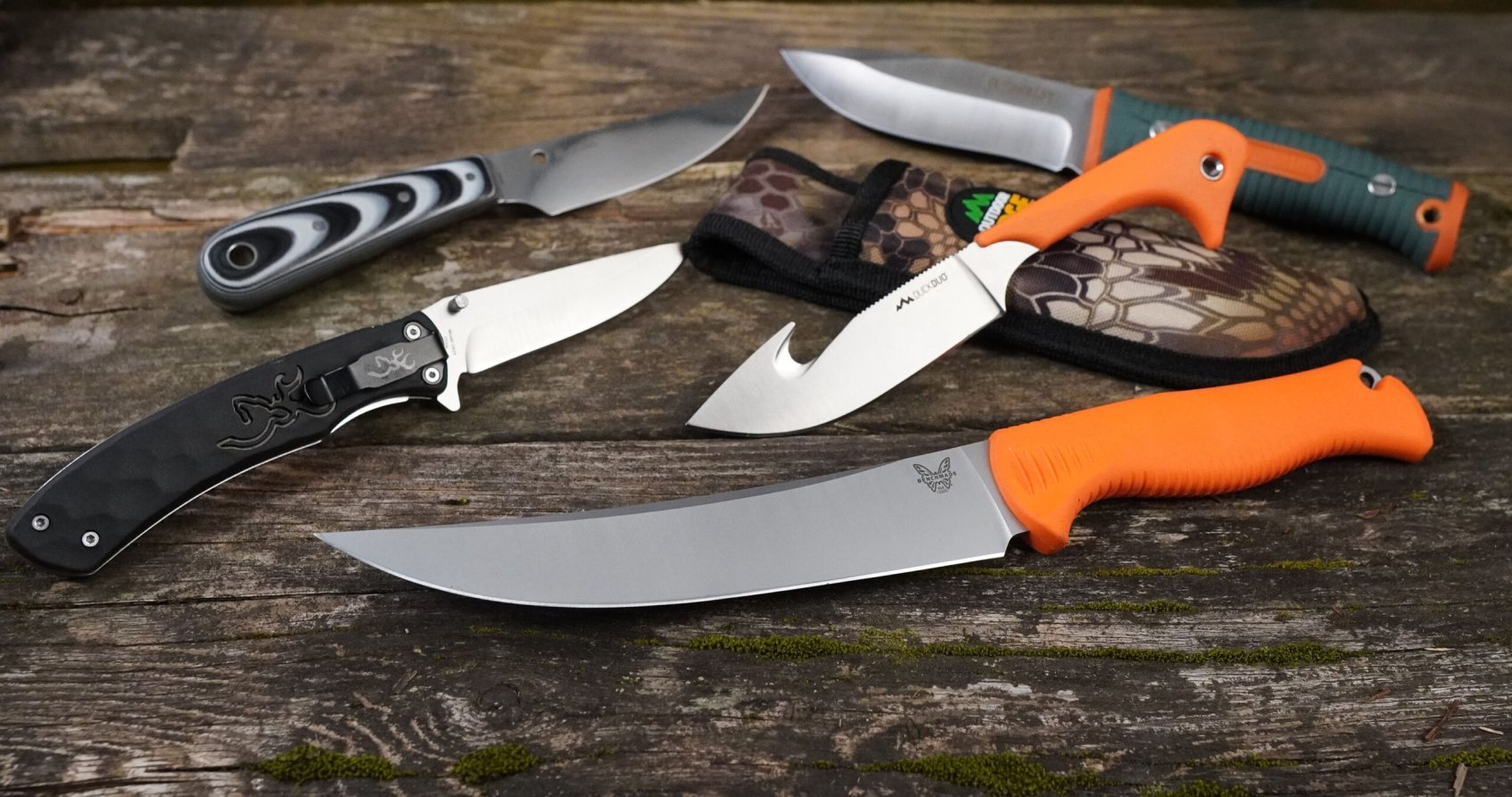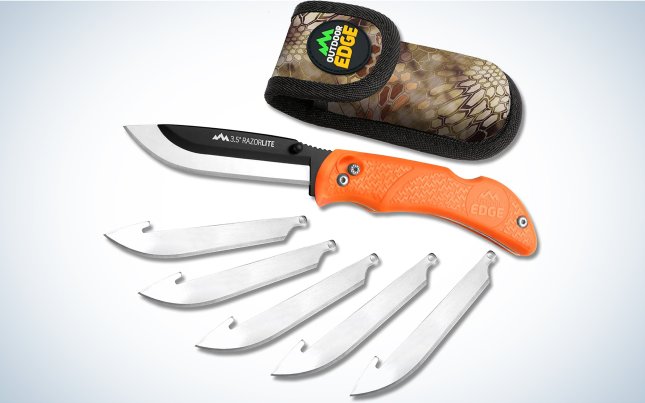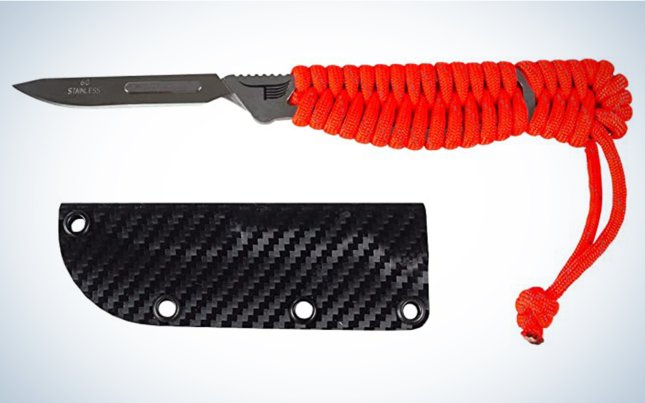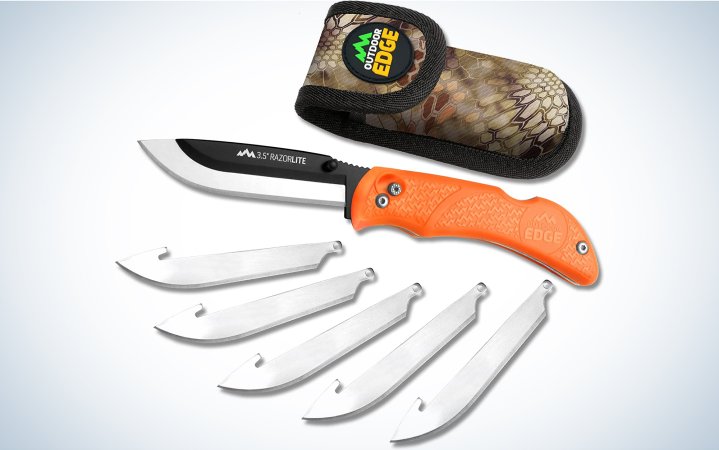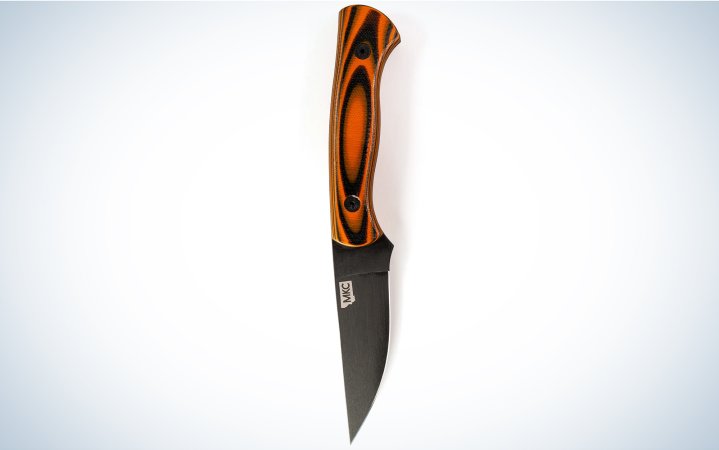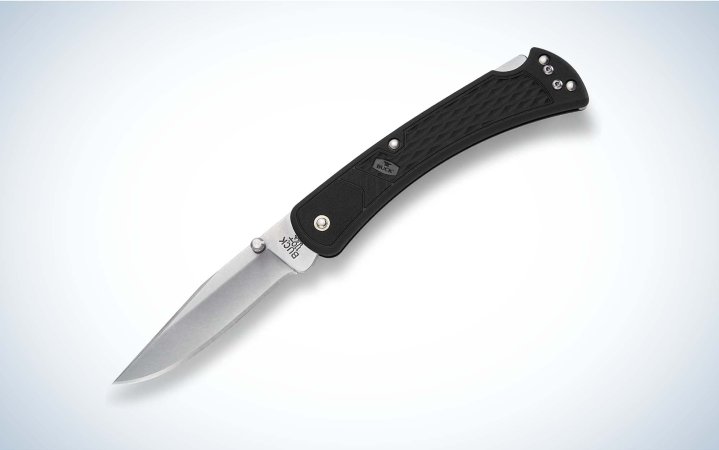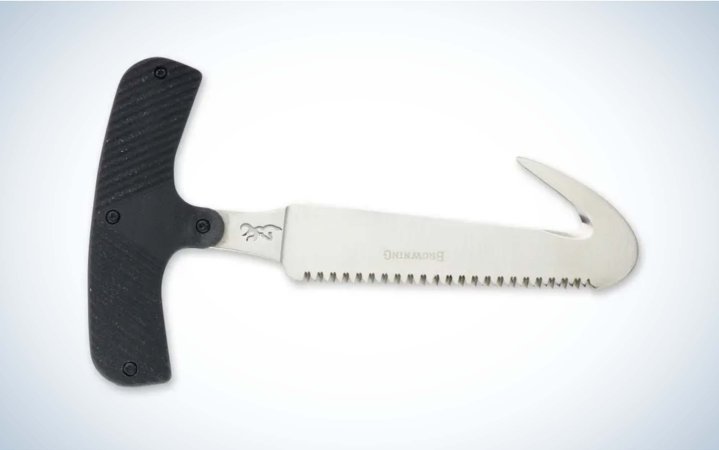We may earn revenue from the products available on this page and participate in affiliate programs. Learn More ›
The first time you clip a deer’s stomach and hot digestive gasses spray into your face, you’ll want it to be the last time. Once the dry heaving subsides, you’ll have learned an important lesson: The best knife for field dressing isn’t a big honkin’ blade, it’s a sharp controllable knife that can make a few precise cuts to free all the organs at once.
I’ve been there and gutted that with a wide variety of knives, and here are a few that will serve you well.
- Best Overall: Benchmade Flyway
- Best Value: Outdoor Edge Razorlite
- Best Ergonomics: Montana Knife Company Blackfoot 2.0
- Best Ultralight: Tyto 1.1
- Best Folder: Buck 110 Slim
- Best Bone Saw: Browning Game Reaper
How I Chose the Best Knives for Field Dressing

I’m a hobbyist knife maker. Also, while I don’t consider myself a collector, I do own a lot of knives. Over the last ten years, I’ve used an assortment of blades to field dress and butcher deer, elk, and small game. I’ve used that experience and my time with each of my selections to write the following reviews.
Best Knives for Field Dressing: Reviews & Recommendations
Best Overall: Benchmade Flyway
Best Overall
Benchmade Flyway
Pros
- Good ergonomics
- Good edge retention
- Light
Cons
- Not ideal for hard-use tasks
Key Features
- Steel: CPM-154 at 58-61 HRC
- Blade Length: 2.7 inches
- Blade Thickness: 3/32 inches
- Weight: 2.1 ounces
- Overall Length: 7 inches
- G10 Handles
- 14-degree bevel
- Kydex sheath
- Made in USA
- Price: $180
I used the Flyway last year to field dress and butcher an entire deer without touching up the blade. Two days later, I used it to butcher pheasants, and afterward it was still sharp enough to push cut paper. Since then, it’s been my favorite hunting knife, and it’s even a handy EDC fixed blade. The things that make it so great for field dressing are its ergonomics and slicey blade.

While field dressing, I typically use a pinch grip with my index finger on the knife’s spine. The Flyway’s sculpted G10 grip and spine jimping work well for that method. Especially the jimping that’s ¾ of the way down the blade. It serves not only to prevent slipping but as an index point so you know where your finger is in relation to the point, even in the dark.
The blade has a drop point and plenty of belly for skinning. While field dressing, the fine point, and slight drop were perfect for making the initial cut where the knife edge is facing up as you slide the knife under the skin. The length makes it easy to control, and when you reach into the chest cavity, it’s easy to know where your knife is.
According to Knife Steel Nerds, the CPM 154 used in the Fly Way is known for good edge retention and it’s tougher than S30V. The toughness makes it a great steel choice for a thin knife.
My only complaint is that the sheath is considerably bulky for such a small knife. That makes the Flyway less convenient to carry in a bino harness or pants pocket.
Read Next: Best Knife Sharpeners
Best Value: Outdoor Edge Razorlite
Best Value
Outdoor Edge Razorlite
Pros
- Easy to replace blades
- Good blade shape
Cons
- Heavier than some replaceable blade knives
Key Features
- Blade Length: 3.5 inches
- Blade Steel: Japanese 420J2 Stainless
- Nylon pouch
- Weight: 6.4 ounces
- Overall Length: 8 inches (open)
- Price: $40
Last year I found myself on the side of a mountain with five others trying to break down two elk as quickly as possible, before the two grizzly bears over the ridge got too interested in us. Everyone had different replaceable blade knives, but about halfway through the first elk, it was obvious which of the knives was the best—the Razorlite. Its blades were the easiest to replace, and the mounting system was trouble-free. Other knives got gummed up, and the blades came off, but the RazorLite zipped through the two elk.
That’s an important consideration because while a number of replaceable blade knives will excel at field dressing, butchering is usually soon to follow. It’s nice to have a knife that does both well.
While the RazorLite isn’t the lightest replaceable blade knife—5.9 ounces heavier than a Tyto—it’s the most trouble-free design I’ve used. I don’t have blades pop off or break, and I can make it through an animal on one blade. When it’s time to swap a blade, you just press the button, slide the blade out, and slide a new blade in. The rubberized group stays grippy when your hands are covered in blood. The 3.5-inch blade is a good length for balancing maneuverability and cutting efficiency.
Best Ergonomics Montana Knife Company Blackfoot 2.0
Best Handmade
Montana Knife Company Blackfoot 2.0
Pros
- Handmade quality
- Versatile blade shape
- Great ergonomics
Cons
- Price
Key Features
- Weight: 3.6 ounces
- G10 Handle
- 52100 Steel
- Blade Length: 3.5 inches
- Overall Length: 7.75 inches
- Free sharpening
- Made in USA
- Price: $300
The ergonomics on the Blackfoot 2.0 are ideal, and it comfortably puts your hand into a natural position without forcing you into a specific grip. That means whether you’re whittling by the fire or making that delicate initial cut while field dressing, you’ll have a comfortable and controllable grip. Adding to the good grip are the sculpted G10 scales, which are a step above the standard flat scales on mass produced knives.
From the factory, the Blackfoot is very sharp and I’ve only needed to occasionally strop mine to keep it that way. It’s worth noting that Montana Knife Company offers lifetime sharpening. The full flat grind slices through meat like butter, and I think the blade shape is perfect for taking an animal from the field to a vacuum sealed bag.
The Blackfoot 2.0 uses 52100 steel, which isn’t the sexiest blade steel. However, 52100 has been around since 1905 and used for knives since at least 1940—so it’s time tested. According to Knife Steel Nerds, it has good toughness and doesn’t have the blade retention of higher chromium alloys. That means you don’t have to worry as much about chipping your edge when you smack into a bone, but you might want to have a honing rod handy while butchering. It’s also worth noting that it’s not a stainless steel and will need to be wiped dry before storage. So while many companies are quick to jump on the latest and greatest steels like Magnacut, it’s great to see a company utilizing a proven entity.
A $300 knife isn’t a small purchase, but consider that if you care for this blade, your grandchildren will use it to field dress their first deer. That heirloom quality shifts the value proposition for me. If you want a USA-made knife and are capable of maintaining your tools, then the Montana Knife Company Blackfoot 2.0 is an excellent option.
Best Ultralight: Tyto 1.1
Best Ultralight
Tyto 1.1
Pros
- Light
- Easy to carry
- Good ergonomics
Cons
- Blades can pop off with side pressure
Key Features
- Weight: 1.5 ounces (handle, one blade, and sheath)
- Overall Length: 7.5 inches
- Width: 1 inch
- Thickness: 0.120 inch
- Uses size 60 replacement blades
- Made in the USA
- Price: $104

A Tyto and spare blades ride in my bino harness and only come out when it’s time to put them to work. When the knife isn’t in use, I don’t even notice it, and that’s where the Tyto shines. It’s a minimalist knife that’s exceptionally light and slim.
The blades pop into place easily, and one blade will stay sharp throughout the field dressing. But you’ll eventually need to replace your blade if you’re deboning and skinning. That’s best done with a pair of pliers, the Havalon Blade Remover, or by sticking the blade into a piece of wood.
The sharp jimping on the spine provides a non-slip grip and an index point. While I’ve never felt the need to wrap mine in paracord or add scales, you have that option for even more grip traction.
Best Folder: Buck 110 Slim
Best Folder
Buck 110 Slim
Pros
- Light
- Under $50
- Folds to easily fit in your pocket
Cons
- Not ideal for hard-use tasks
Key Features
- Blade Length: 3.75 inches
- Overall Length: 8.6 inches (4.8 inches folded)
- Stainless 420 steel with BOS heat treat
- Lockback
- Glass Filled Nylon (GFN) handle material
- Weight: 2.8 ounces
- Made in the USA
- Price: $43
I own the original Buck 110, a fixed blade 110, and the newer 110 Slim. They’re all iconic hunting knives that have proven themselves through hard use by countless outdoorsmen. In my opinion, the best knife for field dressing among the 110 line is the 110 slim, because it’s light, is easier to open thanks to the addition of thumb studs, and blood washes off the GFN handle easily. Fans of the original will be happy to learn that Slim maintains the classic, and rock solid, lockback design and endlessly useful clip point blade. It’s also one of the few knives under $50 that is made in the USA.
Buck Knives opened up shop in 1902, just four years after Outdoor Life, and the company has had a loyal following ever since. If you’re looking for a classic that won’t hurt the wallet or weigh you down, you can’t go wrong with the 110 Slim.
If you want to upgrade from the 110 Slim also check out the 110 Slim Pro TRX and 110 Hunter Sport.
Best Bone Saw: Browning Game Reaper
Best Bone Saw
Browning Game Reaper
Pros
- Easy to pack
- Saws through bones and preserves the sharpness of your hunting knife
- Rounded nose doesn’t puncture guts
Cons
- Limited versatility
Key Features
- Weight: 4.8 ounces (including sheath)
- Blade Length: 3.75 inches
- Overall Length: 5.88 inches
- 440-C steel
- Saw-style blade
- Price: $30
- Made in China
The only issue with using a small knife that has a relatively thin blade is that when it comes time to split the pelvis of a deer, you risk busting that dainty knife’s tip (and with a replaceable-blade knife, don’t even consider cutting through bone). That’s where this affordable little bone saw comes in handy. It allows you to quickly cut through the pelvis to ensure you’ve removed all entrails, without dulling or busting your hunting knife. There are a bunch of mini bonesaws like this one on the market, and they’re all pretty similar. I like the Browning Game Reaper because it’s compact and cheap. Deer hunters who aren’t hiking deep into the backcountry should have no problem shoving this blade into their pack. The sheath also has a belt loop in case you want to go very light and pack-less. The saw does come with a gut hook, but I’ve always thought that feature was a little silly and simply choose to ignore it. —Alex Robinson
Read Next: Best Hunting Knives
How to Choose a Knife for Field Dressing

Steel
We could nerd out on metallurgy, but that’s a topic for another day. Instead, let’s focus on the two main types of steel: carbon and stainless. A carbon steel blade is easier to heat treat, it sharpens quickly, it’s less brittle, and it will rust if kept wet. Stainless steel takes more work to sharpen, won’t rust as easily, holds an edge longer, and is typically harder and, therefore, more brittle.
Size
A 2- to 4-inch knife is ideal for field dressing because it’s long enough to efficiently cut while being controllable. The benefits of a longer blade are that it’s more surface area to use, and your blade won’t get dull as quickly as a result. The downsides of a longer blade are that it’ll be heavier and harder to make precise cuts with.
Blade Shape
Clip and drop points are my favorite style for hunting knives because the tip runs in line with the center of the blade, which makes it easy to know where it is. They also have enough belly for slicing cuts. I’d avoid anything with a trailing point because they can easily poke holes in organs while making your entry cut.
Replaceable or Fixed Blade
I used to exclusively use replaceable blade knives and I still use them on occasion. But, I find myself leaning toward a sturdy fixed blade. The reliability of a fixed blade is bonus, and they’re much easier to clean after a long night of butchering. Fat and bits of meat end up in every crevice of a replaceable blade, even the Tyto, and it makes them a pain to clean out. The positives of a replaceable blade knife are that you can go from a dull to a razor edge in seconds. That’s especially beneficial when you need to work quickly due to warm temperatures.
Final Thoughts on the Best Knives for Field Dressing
The best knives for field dressing allow you to quickly and safely remove organs. That means they must be sharp, offer a secure grip, and make precise cuts. There are hundreds of knives with those qualities, but these options are my favorites for gutting and butchering.
- Best Overall: Benchmade Flyway
- Best Value: Outdoor Edge Razorlite
- Best Handmade: Montana Knife Company Blackfoot 2.0
- Best Ultralight: Tyto 1.1
- Best Folder: Buck 110 Slim
- Best Bone Saw: Browning Game Reaper
